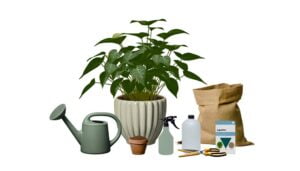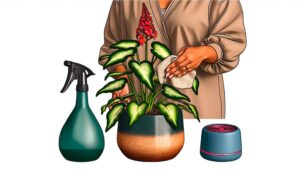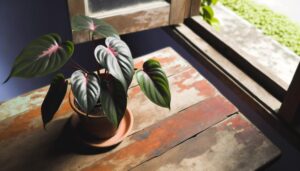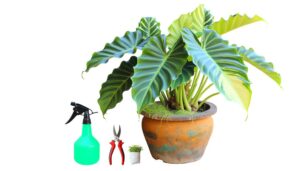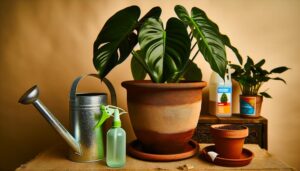Lemon Lime Philodendron Care: Ultimate Guide!
The Lemon Lime Philodendron (Philodendron hederaceum ‘Lemon Lime’) is a vine-like plant that thrives under filtered sunlight and requires consistent moisture without waterlogging. It flourishes in temperatures of 65-80°F, with a relative humidity of 40-50%.
Overwatering or dry conditions impair growth and may cause leaf scorch. Regular fertilization with a balanced amount of Nitrogen, Phosphorus, Potassium, and micronutrients is essential, accompanied by careful monitoring of the pH level of the potting medium (aiming for 6.0-7.0).
Initial symptoms of wilting and discoloration should be addressed promptly. Further exploration will equip you with techniques for identifying issues and implementing effective solutions.
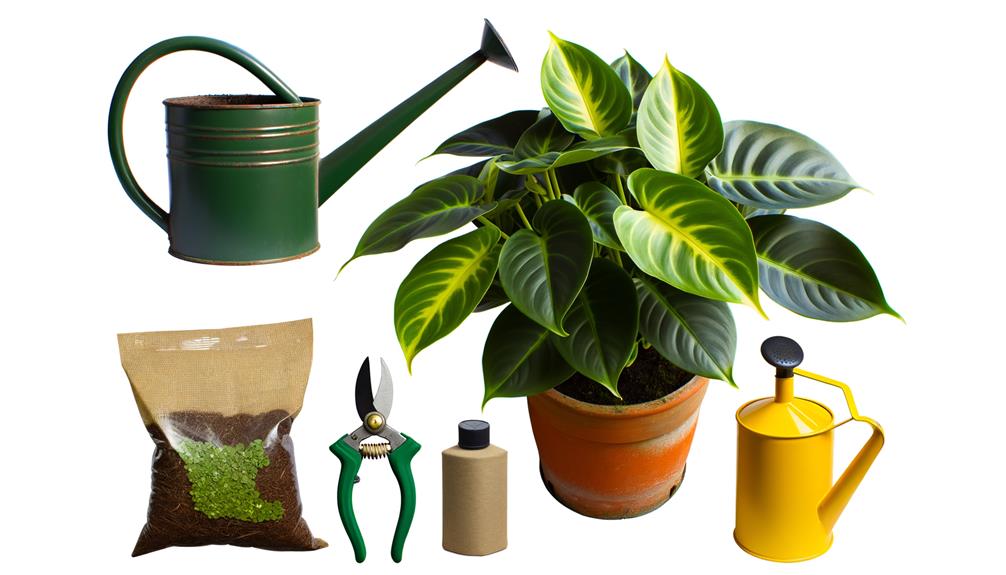
Key Takeaways
- The Lemon Lime Philodendron thrives in filtered, indirect sunlight and can suffer leaf scorch from direct exposure.
- Watering should employ the ‘soak and dry’ method, with caution to avoid overwatering that could cause yellowing leaves.
- Ideal growing conditions involve temperatures between 65-80°F and a relative humidity of 40-50%.
- Regular fertilization with a balanced, water-soluble fertilizer is necessary for optimal growth; excessive fertilization should be avoided.
- Common issues like leaf yellowing, brown tips, and slow growth can be addressed by monitoring and adjusting water, light, and nutrient conditions.
Understanding Lemon Lime Philodendron

To fully comprehend the care requirements of the Lemon Lime Philodendron, it is important to delve into its unique botanical traits and growth habits.
Scientifically categorized as Philodendron hederaceum ‘Lemon Lime’, this variety belongs to the Araceae family. Indigenous to the tropical Americas, it displays vine-like growth with heart-shaped leaves that shift from a vibrant lemon-lime hue to deeper green as they mature.
This epiphytic plant can thrive in various environments, including tree trunks or rocks, absorbing nutrients from its surroundings. It develops an aerial root system, enabling it to climb upwards of 6 feet. Understanding these traits is fundamental to providing ideal care, serving to enhance both its health and aesthetic appeal.
Ideal Lighting Conditions
Understanding the lighting needs of the Lemon Lime Philodendron requires an understanding of its natural habitat, typically characterized by filtered, indirect sunlight. This species thrives when exposed to bright but soft light, mimicking the shadowy undergrowth of tropical rainforests.
Exposure to direct sunlight, particularly during the peak hours of the day, can cause leaf scorch and discoloration. Conversely, inadequate light may stunt the plant’s growth and dull its vibrant coloration.
Notably, these plants exhibit light-directed growth, or phototropism, bending towards the light source to maximize photosynthetic efficiency. Interestingly, periodically rotating the plant can promote balanced growth. For indoor cultivation, placing the plant near an east or north-facing window is ideal. Artificial grow lights can also be used to supplement natural light.
Proper Watering Techniques
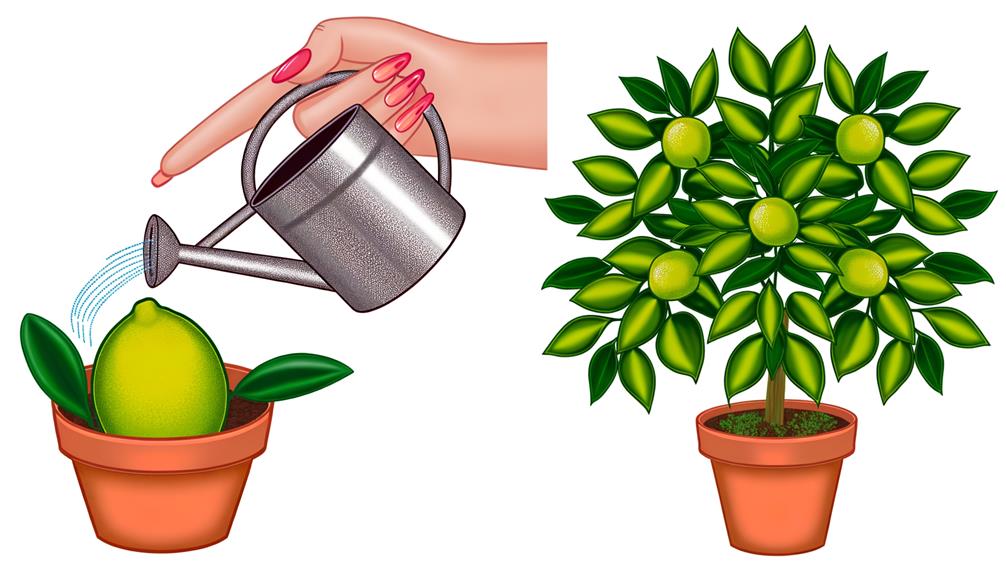
The proper hydration of a Lemon Lime Philodendron is a critical aspect of its overall care. It is contingent upon a thorough understanding of its unique water requirements.
Overwatering is a common oversight in plant care. It can lead to detrimental effects, requiring early detection and effective solutions.
To guarantee ideal growth and health, it is essential to adhere to best watering practices tailored to the needs of this particular variety of Philodendron.
Understanding Plant Hydration Needs
Evaluating the hydration needs of your Lemon Lime Philodendron involves careful observation and a solid understanding of proper watering techniques. It’s vital to recognize that these plants thrive in a moist environment but not in waterlogged conditions. To maintain a balance is key.
To achieve this, use a ‘soak and dry’ method where you water the plant thoroughly, then allow it to dry out partially before the next watering. The frequency depends on environmental factors like temperature and humidity. High temperatures and low humidity may require more frequent watering.
Moreover, the plant’s growth stage and size also influence its water requirements. It’s a delicate balance that requires consistent monitoring and adjustment to ensure optimal plant health.
Overwatering: Signs and Solutions
Recognizing the signs of overwatering in your Lemon Lime Philodendron is important to prevent damage and maintain best plant health; these symptoms might include yellowing leaves, a sudden drop of foliage, or a wilted appearance despite adequate watering.
Overwatering leads to waterlogging, creating anaerobic conditions that hamper root respiration, impair nutrient absorption, and trigger root rot. The plant’s defense mechanism reacts by shedding leaves to conserve resources.
To rectify overwatering, first, halt watering and allow the soil to dry out. If the plant’s condition doesn’t improve, consider repotting in fresh, well-draining soil. Avoid future overwatering by observing the plant’s hydration needs, modifying watering frequency as per seasonal changes.
Best Watering Practices
Understanding the optimal watering techniques for your Lemon Lime Philodendron can significantly reduce issues such as overwatering, promoting strong plant health and growth.
These plants prefer the top 2 inches of soil to dry out between waterings, which is best determined using a moisture meter for accuracy.
Excessive water retention can result in root rot, so make sure your plant pot provides ample drainage.
Additionally, the quality of water is crucial; use filtered, room-temperature water to prevent salt buildup in the soil.
The plant’s watering needs may decrease during winter due to reduced light and temperature.
Regular monitoring of the plant’s health and adjusting watering practices accordingly is the key to maintaining a thriving Lemon Lime Philodendron.
Importance of Temperature and Humidity
In the field of horticulture, maintaining ideal temperature and humidity levels is essential for the healthy growth of the Lemon Lime Philodendron. This tropical plant thrives in temperatures between 65-80°F, with a relative humidity of at least 40-50%.
Lower temperatures or dry conditions can hinder growth and lead to leaf desiccation. On the other hand, excessively high temperatures or humidity can encourage the proliferation of pathogenic fungi, leading to diseases such as leaf spot or root rot.
Therefore, monitoring the microclimate around the Philodendron is important for its well-being. A hygrometer can provide precise humidity readings, while a standard indoor thermometer can measure temperature.
Regular adjustments based on these readings will ensure the plant thrives in an ideal environment.
Nutrient Needs and Fertilization
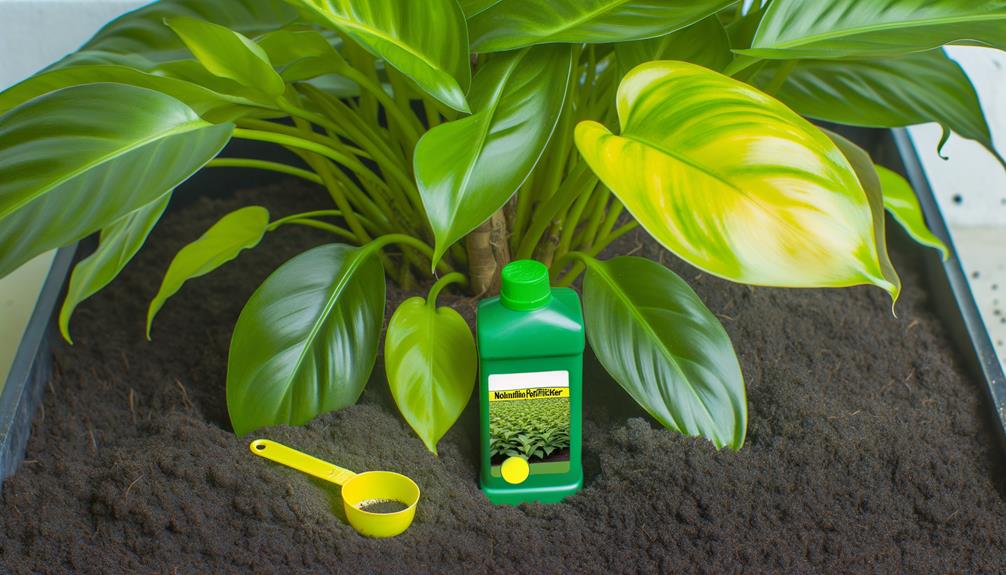
Beyond the strict control of temperature and humidity, another remarkable aspect of Lemon Lime Philodendron care is the plant’s nutrient requirements and the role of fertilization in meeting these needs.
A thorough nutrient management scheme is critical, with emphasis on Nitrogen (N), Phosphorous (P), and Potassium (K), the primary macronutrients needed for plant growth. However, micronutrients such as Iron (Fe), Manganese (Mn), and Zinc (Zn) shouldn’t be neglected. Regular fertilization with a balanced, water-soluble fertilizer can suffice for these needs.
However, excessive fertilization should be avoided to prevent nutrient toxicity and root burn. Lastly, the pH of the potting medium should be monitored to ensure ideal nutrient uptake, ideally maintaining it between 6.0 and 7.0.
Pruning Your Philodendron
As we continue with our examination of Lemon Lime Philodendron care, our focus now shifts to the crucial procedure of pruning. Pruning is not merely a cosmetic measure; it plays a significant role in the plant’s health, influencing growth patterns, plant structure, and disease prevention.
We shall explore the fundamentals of effective pruning, as well as the necessary steps for post-pruning care to guarantee the longevity and essentiality of your Philodendron.
Pruning Basics
While the Lemon Lime Philodendron is a relatively low-maintenance plant, proper pruning techniques can greatly enhance its growth and overall aesthetic appeal.
Pruning should ideally be done during spring or early summer. Use sharp, sterilized shears to make clean cuts at a 45-degree angle, just above a leaf node. This will encourage lateral growth and denser foliage. Regularly remove any yellowing or dead leaves to maintain plant health and vigor. Always wear protective gloves as the plant’s sap can cause skin irritation.
For best results, it’s key to take a methodical, scientific approach, analyzing the plant’s growth pattern and tailoring the pruning process accordingly.
Post-Pruning Care
Following the pruning process, immediate attention to post-pruning care is crucial in sustaining the health and growth of your Lemon Lime Philodendron. Assess the plant for any signs of stress post-pruning, such as wilting or discoloration.
If these symptoms are observed, make sure you are providing ideal light, temperature, and humidity conditions. Water the plant moderately but avoid overwatering, as it may lead to root rot. Promote recovery by providing a balanced fertilizer to replenish essential nutrients.
Monitor the plant closely for several weeks to ensure it recovers well. Early detection of any post-pruning issues will enable swift corrective measures, thereby securing the overall health and longevity of your Philodendron. This attentive post-pruning care is crucial for the plant’s flourishing growth.
Troubleshooting Common Problems
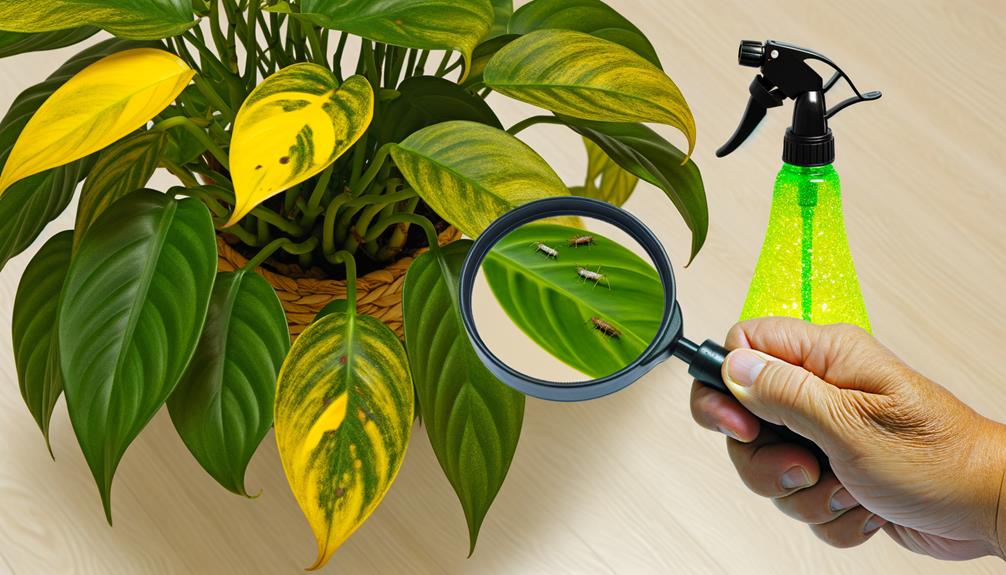
Numerous issues can potentially affect the health of your Lemon Lime Philodendron, each with its own set of identifiable symptoms and appropriate treatment strategies.
- Leaf Yellowing: This could be due to overwatering. The plant’s roots may be waterlogged, resulting in a loss of necessary oxygen. Allow the soil to dry out before the next watering session.
- Brown Leaf Tips: This might be a sign of low humidity or over-fertilization. Increase humidity by placing the plant on a tray of pebbles and water, and reduce the frequency of fertilization.
- Slow Growth: Insufficient light or nutrients might be the cause. Increase light exposure and use a balanced, slow-release fertilizer.
Understanding these problems and responding appropriately can help guarantee the longevity and vibrancy of your Lemon Lime Philodendron.
Propagation Methods
After ensuring the health and strength of your Lemon Lime Philodendron, the next step in its care involves understanding the proper methods of propagation.
The primary method employed is stem cutting, a technique that involves severing a portion of the stem with a sterile tool and planting it in a conducive environment. This process, best conducted in the early spring, triggers the plant’s natural regenerative mechanisms.
Leaf bud cuttings, another viable method, involve cutting a leaf along with a small piece of the attached stem. It’s essential to monitor temperature, light, and humidity conditions during these processes, as these factors greatly influence the success rate.
Propagation serves not only to increase your plant collection but also to promote the longevity and robustness of the original specimen.
Neon Philodendron Care
- Light: Place in bright, indirect light. Avoid direct sunlight to prevent leaf burn.
- Water: Water when the top inch of soil is dry. Ensure the pot has drainage holes to prevent waterlogging.
- Temperature: Maintain temperatures between 65-80°F (18-27°C). Avoid cold drafts and sudden temperature changes.
- Humidity: Prefers high humidity. Mist regularly or use a humidifier.
- Soil: Use well-draining soil, such as a mix of perlite, peat moss, and indoor potting mix.
- Fertilizer: Feed every 4-6 weeks during the growing season with a balanced, diluted liquid fertilizer.
- Pruning: Remove dead or damaged leaves to promote healthy growth.
- Repotting: Repot every 1-2 years into a slightly larger pot with fresh soil.
Following these care tips will help your Neon Philodendron thrive and remain healthy.
Conclusion
To sum up, cultivating the vibrant Lemon Lime Philodendron requires a harmonious balance of ideal lighting conditions, sufficient watering, appropriate temperature, and humidity, specific nutrient and fertilization requirements. Proper pruning enhances growth, while troubleshooting common problems maintains robust health.
Propagation methods can extend the life of this plant, contributing to its ongoing vibrancy. This meticulous care regimen contributes to the captivating, radiant beauty that makes the Lemon Lime Philodendron a stunning addition to any indoor garden.

